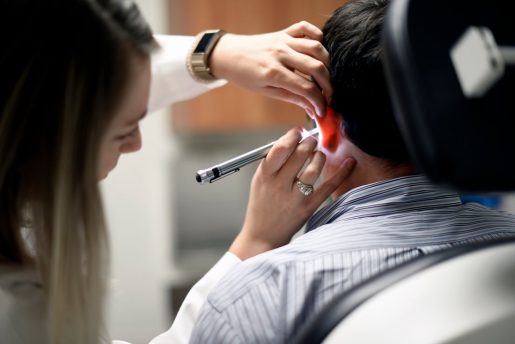Cotton swabs, earbud headphones, earplugs – what should and shouldn’t go inside your ear
For many, cleaning out ear wax is a typical part of the morning routine.
Take a shower, dry off, brush your teeth and swab a piece of cotton in the ear canal before putting the coffee on, right? Wrong.
 Dr. Deyanira Gonzalez, a clinical audiologist in the Bobby R. Alford Department of Otolaryngology, has the answer to whether we should be cleaning our ears, and it’s one that we may not want to hear: No.
Dr. Deyanira Gonzalez, a clinical audiologist in the Bobby R. Alford Department of Otolaryngology, has the answer to whether we should be cleaning our ears, and it’s one that we may not want to hear: No.
If there is a noticeable buildup of ear wax, it may be time to see a physician, Gonzalez said. Using cotton swabs, better known by the brand name Q-Tips, can result in pushing the wax further into the ear canal and creating a plug.
Ear wax, a combination of sebum, is produced by glands in the ear canal. Made up of mostly skin and sweat, the purpose of wax is to clean the ear canal. There are two types of ear wax: wet, which is dark and sticky; and dry, which is light in color and flaky.
Ears are self-cleaning, she said. The ear canal pushes ear wax out little-by-little all day, but it’s hard to notice, Gonzalez said. If there is a feeling of “too much” ear wax, hair or the shape of the ear canal may be slowing the migration of the wax.
“When we introduce a Q-tip or another tool, it’s slowing that process of coming out on its own,” she said. “We have to be careful. It’s always best to see a physician if further action may be needed but leave it alone.”
Gonzalez often sees patients who say they have cleaned their ears, but still can’t hear well. What she finds is they have pushed the wax further into their ear, so she can’t see the ear drum. She has seen pieces of a cotton swab embedded into the wax, as well as perforation and bleeding on the ear drum caused by trauma of cotton swab usage.
Using cotton swabs could injure the ear drum and skin on the ear canal, as well. A cotton swab can remove natural moisture the ear canal needs to do its own self-cleaning process and could lead to ear infections and itchiness.
“Having a clean ear won’t make it more prone to auditory damage, but you’re removing secretions that are needed in the ear canal,” Gonzalez said.
Is the ear canal a complete Do Not Enter zone?
Headphones and earbuds (headphones that are inserted into the ear) are OK to use, but pay attention to the volume level, she said. It helps if the headphones are a tighter fit because it helps filter out ambient noise.
When listening to music or podcasts, it’s safest to use over-the-ear headphones because they are designed to block out external noise, Gonzalez said. However, most phones are now sold with a type of earbud headphone, which she said are fine to use if the volume isn’t too high.
They need to fit snugly, though.
“If they’re tighter, there’s better noise cancellation,” she said. “Loosely-fit earbuds can lead the person to crank up the volume so they don’t hear other sounds.”
More than 20% of people experience some type of tinnitus, a constant ringing in one or both ears. It can be related to preexisting hearing loss, noise exposure or undiagnosed auditory damage, Gonzalez said. For some, medications or medical procedures can cause tinnitus.
Since ear ringing is so common, Gonzalez recommends people wear earplugs in loud environments. The most common type of earplugs made of a foamy material and is sold at most pharmacies and box stores.
To properly wear an ear plug, 90% of it should be in the ear canal. If it’s sticking out, it’s not protecting the ear, she said.
“If you’re going to be somewhere extra noisy, like hunting or at a firing range, it is best to double up with earplugs and ear muffs to get extra protection,” she said. “There are many types of earplugs provided by audiologists. Depending on the situation you’re using them in, they will help you.”
-By Julie Garcia



